Saturday, February 12, 2005
Rene Pascal, who has been doing a great job with the released Huygens, has done perhaps THE best Huygens mosaic released by an enthusiast (or even by the DISR team) to date. This mosaic shows the widest field of view, showing the entire bright island and the surrounding terrain. I am still trying to evaluate all that can be seen in this image including what it can say about where we landed. The first problem for me is size scale and perspective. How large is the large bright island seen in the image, for example? How wide is the dark channel to the chaotic island to the south? Once these issues are resolved I think we can use this to find out where Huygens landed. In the mean time, I encourage all of you to check out this mosaic.
Friday, February 11, 2005
Huygens Processing

I've attempted some photometric corrections of the Huygens images, similar to what Rene has done, by flatfielding each image to remove issues created by the DISR CCD. The above mosaic has not been in the least bit geometrically corrected so take the matching with a giant grain of salt, but I think the flat-fielding attempts, which are best seen at the tops of each frame, seem to have been worth it.
Cassini Significant Events 02/03/05 - 02/09/05
The Significant events report for this past week is now up. Activity on Cassini and in the instrument and support teams are starting to ramp up in preparation for next week double encounter, first with Titan on Tuesday and Enceladus on Thursday. The report mentions the current movie sequence to track clouds in Saturn's atmosphere.
More Raw Images
Here are some links to more satellite raw images:
- Rhea's ray system. This view is very similar to one released back in November.
- Dione's Padua Linea
- Gibbous View of Titan in clear filter
- Dione's Aeneas and Dido craters
New Raw Image: Tethys and Odysseus
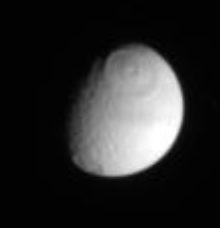
This new raw image of Tethys taken Wednesday prominently shows Odysseus crater, the north-south albedo assymmetry, and a crater discovered last year near Tethys' south pole.
New Tethys Image: The Great Rift
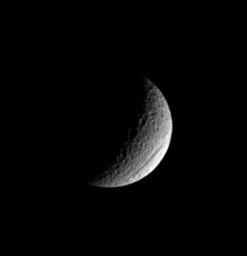
This medium resolution view (~6 km/pixel) of Tethys taken last month shows a cresent Tethys with the southern end of Ithaca Chasma in full view. Ithaca Chasma is a long fracter that runs 3/4 of the way around this mid-sized icy moon. While lower resolution than a few other views taken of Tethys, this is one of the best views of this region of the moon.
Thursday, February 10, 2005
New Mimas Image: Herschel: Dead-On
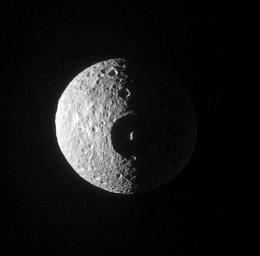
CICLOPS has released a newly processed view of Mimas taken last month shortly after the Huygens landing on Titan. This view shows Herschel (named after the discoverer of Mimas) straddling the sunset terminator, with the central peak just poking up into view. A very dramatic view of Mimas. Cassini's next close pass of Mimas will take place on April 15.
Wednesday, February 09, 2005
Anaglyphs of Huygens Images
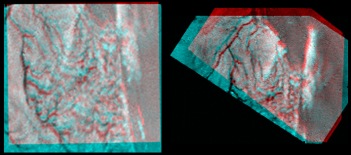
Cosmic Rocker over at the MER Forum has posted a couple of anaglyphs based on the stereo pairs released by the DISR team this past weekend. These two show areas where I suspect topographic features can be seen. When rotated as I have them in the preview pic above, the topographic features show up. When rotated as Cosmic Rocker has them, I'm not so sure. So definitely the jury is still out on these features. Regardless, these anaglyphs are very well done, so I thought I would share them here.
New Huygens Panorama from Rene Pascal
Rene Pascal has posted a new panorama he created using the publically released Huygens raw images. This is one of the more accurate panoramas created by enthusiasts to date, both in terms of geometry and photometric correction. The flat-fielding steps he uses are very well done and I commend him for trying that out. I wish I had thought to do that. I've even tried them out using the image processing software we have and it seems to work quite well :)
Planetary Society: Radio Astronomers Rescue Science Results for Huygens' Doppler Wind Experiment
The Planetary Society has an article up by Emily Lakdawalla reporting on today's Doppler Wind Experiment announcement. This is a definite recommend over the two press releases posted below thanks to the thoughness of the reporting (*gasp* she actually interviewed the people involved, I'm amazed). While most of the details are not any different from what was reported in the press releases, this article does a good job in explaining the significance of the Doppler Wind Experiment results and the work that went into retrieving its data. On particular passage caught my eye:
Another useful application of the Doppler Wind Experiment data is to figure out exactly where Huygens landed. Although maps showing a location for Huygens' landing site have been published, Cassini-Huygens scientists privately express doubt that the dot marks the right spot. The three-dimensional profile of Huygens' motion that will eventually be produced from the Very Long Baseline Interferometry observations should allow scientists to pinpoint exactly where Huygens landed by tracing its path from its entry point to the surface. Preliminary calculations from the zonal wind profile released today suggest that the landing site "is going to be a good 100 or 150 kilometers [60 to 90 miles] from where we went in," Bird says. "We dropped 150 kilometers, and I have a feeling that we drifted about that same amount in the easterly direction."
Press Release: Radio Telescopes "Save the Day," Produce Data on Titan's Winds
The National Radio Astronomy Observatory released an announcement regarding there involvement in recovering the Doppler Wind Experiment data. Nothing really new but it is good to see they are getting the recognition they deserve for a job well done.
New Enceladus Image: Wrinkles of Youth?
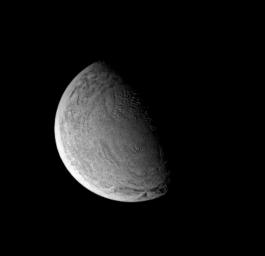
CICLOPS has a released a newly processed image of Enceladus taken last month. This view reveals a very young surface almost no craters (at least none 5 km in diameter or larger). This view is but a preview of things to come as Cassini will flyby this mysterious moon next week, taking images 200 times better than this view. For an unsharpened version, try the entry for this image on the JPL Raw Images page.
Press Release: First measurement of Titan’s winds from Huygens
Following a post from a few weeks ago, the ESA is reporting in a press release on the successful retrieval of the Doppler Wind Experiment data from ground-based radio telescopes. The data was to be retrieved by both ground-based observers and Cassini via Channel A, one of two nearly redundant radio frequencies used by Huygens to transmit its once-in-a-lifetime data. Unfortunately, due to an apparent programming error, Channel A was not retrieved by Cassini, but was retrieved by the ground-based observers. Combined with the precision VLBI measurements of Huygens position, Huygens scientists are beginning to deconvolve a wind profile for Huygens during its descent. As mentioned earlier, the winds were very low near the surface (also shown in the DISR images from the relative lack of lateral movement) and increased steadily to a height of 60 km (10 km above the tropopause). Additionally, this press release mentions that the winds were highest at an altitude of 120 km with wind speeds clocked at around 120 meters/second (compared to 40-50 meters/second at an altitude of 60 km). Finally the press release confirms that the winds were quite choppy high up (something Jonathan Lunine alluded to in his talk a few weeks ago).
Tuesday, February 08, 2005
ISS filter wavelengths
Where has this page been all my life?!? I finally found a page with all the ISS filters with WAVELENGTHS listed. Sure, I could just ask for the instrument description paper, but this is just as useful.
Link of course is in the title...
Link of course is in the title...
Mimas Blues
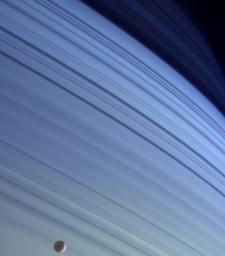
CICLOPS has released a true-color version of a view showing Mimas against the backdrop of the ring-shadowed, Saturnian northern hemisphere. CICLOPS posted the IR1 (752 nm broadband) filter version last week. The blue color of Saturn's northern hemisphere results from the relative lack of clouds, allowing sunlight to penetrate farther in the its atmosphere. CICLOPS also released a more head-on view of that region of Saturn. These views of Saturn are really quite beautiful.
Titan-3 Mission Description and other products
JPL has released a pdf with a description of science goals for the Titan-3 encounter. The most important part of this document for this blogger is the playback table, which tells me when each ISS observation will be played back to Earth, so I know when to be at work (if at some ungodly hour) in order to process image. I'm not quite sure what the difference would be between when the images are supposed to be downlinked to when they show up on the JPL Raw images page, it could be 15 minutes, it could be 9 hours, I'm just not sure. I will likely be too busy to put it an alert up here.
In finding that they released this document, the Cassini homepage had linked to their products page, in addition to the document itself (as I did with the title above). At this site, there are lectures on CIRS science at Iapetus and Phoebe and a presentation on Iapetus in general. So those might be worth checking out.
UPDATE: Interestingly enough, not much info is included on the Enceladus encounter next week...
In finding that they released this document, the Cassini homepage had linked to their products page, in addition to the document itself (as I did with the title above). At this site, there are lectures on CIRS science at Iapetus and Phoebe and a presentation on Iapetus in general. So those might be worth checking out.
UPDATE: Interestingly enough, not much info is included on the Enceladus encounter next week...
Monday, February 07, 2005
Planetary Society Huygens Article
The Planetary Society has an article up today recounting the story of how Huygens was tracked from Earth and the behind the scenes scrambling to deconvolve some of the data before a press-conference the day after the landing. A very interesting article and quite thorough.
More New Raw Images
About once a week I will make an effort to post some of my favorite new raw images. The past couple of days have seen upwards of several hundred Saturn images, part of a 3x3 movie sequence to look at cloud motions on Saturn (not unlike the cloud movies of Titan taken during T0, Ta, and Tb). A lot of cool images from that set, but nothing really to post here. I suggest you check them out for yourselves. If you see a bunny, post a comment and I will post it up here on the big board :)
So without further ado:
So without further ado:
Followup: Polydeuces and new Saturnian Names
Last week I reported on two new Saturnian satellite names, Narvi (an irregular outer satellite) and Polydeuces (a trailing trojan of Dione). According to the Krioma.net blog, the IAU has changed the spelling of three other satellite names. Suttung (S/2000 S 12) is now Suttungr. Skadi (S/2000 S 8) is now Skathi. Finally, Thrym (S/2000 S 7) is now Thrymr.
More on the Stereo Pairs
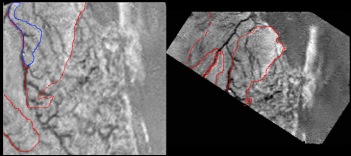
As posted here on Saturday, the DISR team has posted a few stereo pairs showing topography (or lack thereof) in the Huygens landing site region. I commented about a number of topographic features that seem to not be confirmed by others on the net, such as those who post on the #space IRC channel over at freenode.net. So I would like to further elaborate on the features I see in Stereo A and D pairs. I am convinced they are real since the plateau that is overlapped in both appears to me as a plateau in both pairs in the same shape, a plateau that slopes to the east (up in both pairs). This view is also supported by the channels that cross-cut this plateau which appear to run toward the delta near the top of stereoD.
I have made a few jpegs that show both stereo pairs and outline topographic highs in red. The blue outline represents further topographic highs on the plateaus.
Enceladus Crescent
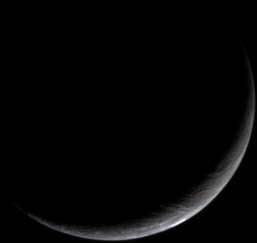
CICLOPS has released a newly processed crescent view of Enceladus. This image was taken shortly after the Huygens landing last month. Believe it or not, but that is a true color view. Apparently Enceladus is pretty monochromatic at high phases (or at least this area of Enceladus). Geologically, there is an interesting ridge feature running from the limb to the terminator, reminicent of the double ridges found on Europa or Triton, or the "landing strip" feature seen by Huygens on Titan. Cassini will get a great view of the "Voyager 2" region of Enceladus next week.

